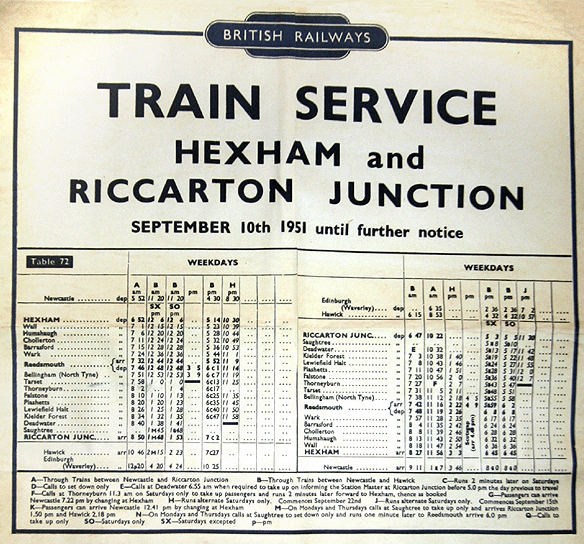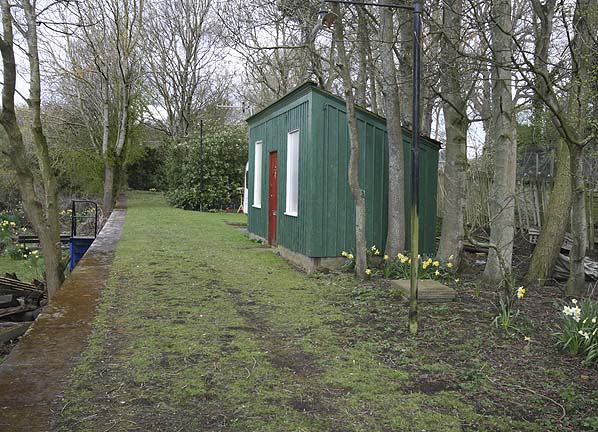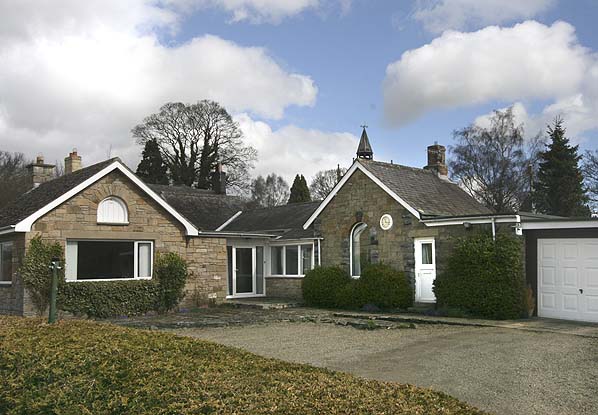Notes: Originally the short platform on the up side had a twin-pavilion single-storey building with central enclosed verandah, accompanied by semidetached cottages to the north and goods loops and a coal depot to the south. A small goods shed was sited on the platform at the south end.
Rather than extend the platform the NBR constructed a new one to the north, with a modest wooden shelter. The original buildings remained in use. The sidings were reorganised so that one of the two goods docks used the old platform. There was a 3 ton crane in the goods yard.
Chollerton station closed to passengers on 15th October 1956 but remained open for goods traffic until 1st September 1958.
BRIEF HISTORY OF THE BORDER COUNTIES RAILWAY
(HEXHAM-REEDSMOUTH-RICCARTON JUNCTION)
This 42-mile, single-track railway began at Border Counties Junction, west of Hexham. It followed the North Tyne to its source at Deadwater, the scenery changing from rich pastures to wild moorland beyond Bellingham. Entering Scotland at Deadwater the line continued several miles to meet the ‘Waverley Route’ at Riccarton Junction. The surrounding countryside was sparsely populated: Bellingham (1,200 inhabitants) was the largest place served. From the 1920s much of the moorland was transformed by the planting of Kielder Forest, a huge blanket of conifers. Until recently, when the Galloway Forest exceeded its extent, it was the largest artificially-planted forest in Great Britain.
 |
The North Tyne valley was recognised, but rejected, as a possible Anglo-Scottish railway route by a Commission of 1839. In 1846 the Newcastle & Carlisle unsuccessfully proposed a Hexham-Bellingham-Woodburn branch to join the projected Newcastle, Edinburgh & Direct Glasgow Railway. However on 31 July 1854 the Border Counties |
Railway, chaired by local landowner, W H Charlton, obtained consent for a Hexham-Bellingham-The Belling (near Falstone) line. The project engineer was J F Tone, and William Hutchinson was contractor.
On 11 August 1859 –by which time the BCR had opened from Hexham to Chollerford – an extension into Scotland was approved, to meet the North British Border Union Railway at Riccarton. This Hawick-Carlisle line, part of the Edinburgh-Carlisle ‘Waverley Route’, had itself been approved on 21 July 1859.
The North British, anxious to reach Tyneside, was prepared to help finance the Border Counties extension and operate the line. As part of this strategy the NBR Chairman was a board member of the Wansbeck Valley Railway, which obtained approval on 8 August 1859 for 25¼ –mile railway from the Border Counties near Bellingham to Morpeth, linking with the Blyth & Tyne Railway. This would allow NBR working between Scotland and New Bridge Street, Newcastle (opened 1864) without using NER metals. Access to the port of Blyth would also be obtained. However full running powers between Hexham and Newcastle were gained by the North British when the NER absorbed the N&C in 1863. The independent NBR route via Bellingham and Morpeth became unnecessary, and the planned junction with the Wansbeck Valley route, originally intended to be at Bellingham, was to be at Reedsmouth instead, and facing Hexham.
 |
Enough land along the Border Counties line was bought for double track, and major masonry structures (except Border Counties Bridge) were built to double track dimensions and of excellent quality. However a single track sufficed. The line rose from about 120ft at Hexham to about 870ft approaching Riccarton, with a ruling gradient of 1 in 100. The difficult terrain required numerous curves and earthworks, and several viaducts. Border Counties Bridge, immediately north of Border Counties Junction, and east of the confluence of the rivers North and South Tyne, had four spans over the river, the wrought-iron girders carried 15ft above water level on cast-iron tubular piers, and smaller spans on the north bank. This bridge was subject to severe erosion, partly offset by the provision of cutwaters. Following the August 1948 floods, the southern span needed strengthening with timber props. After closure the piers and girders were removed. At Reedsmouth the five skew-arch Rede Bridge was of stone and 30ft high. Only the piers survive today. Kielder Viaduct was the line’s finest structure, 130yd long and 55ft high, and decorated with battlements to complement Kielder Castle. The design was remarkably complex. The skew-arches incorporated a system devised by Peter Nicholson, a Newcastle geometrician, whereby each stone was individually shaped. The viaduct is designated an Ancient Monument. A five-span viaduct (now demolished) crossed Dawstonburn, near Saughtree. Smaller skew-arch viaducts survive at Chollerford and Tarset.
| The first section, Hexham to Chollerford, opened to passengers on 5 April 1858. Four weekday and two Sunday trains ran each way. On 1 December 1859 the line opened to Countess Park, about 1¾-miles south of Reedsmouth. Bradshaw of December 1860 showed three Hexham-Countess Park weekday trains each way, the two return Sunday trains working only to Wark. In February 1861 Countess Park closed when the line was opened to Thorneyburn. Onward, sections to Falstone opened on |
 |
2 September 1861 and Kielder on 1 January 1862. Riccarton was reached in April 1862, goods services being introduced in June, and passenger trains on 1 July 1862 to coincide with the opening of the full Waverley route between Carlisle and Edinburgh.
TRAIN SERVICES
In 1863 the Border Counties had four weekday and two Sunday trains in each direction taking approximately two hours for the 42-mile trip. By 1870 the service was reduced to three weekday trains. Even in 1863 certain trains omitted some station calls; in 1870 Saughtree and Thorneyburn had fewest trains. Thorneyburn had only one request stop in each direction on Saturdays and was relegated to the footnotes. By 1910 the three weekday trains were supplemented by a Saturday train at 2.15 pm (Bellingham-Hexham) and a 7.00 pm (Hexham-Bellingham). A mid-afternoon return service from the Wansbeck Valley worked between Bellingham and Reedsmouth. Now Thorneyburn enjoyed only a Tuesday service with a southbound departure at 7.24 am and northbound at 12.50 pm allowing a visit to Hexham market. The 1943 timetable still showed three weekday trains -with a daily service each way calling at Thorneyburn- but no extra Saturday workings. A W Stobbs (1992) provides a fascinating analysis of Saturday-only trains from 1944, highlighting a surprising amount of non revenue-earning empty stock movements, which must have been far from economic!
Motive power was at first 2-2-2 and 2-4-0 tender engines, giving way to 4-4-0s and 0-6-0 working passenger and freight respectively. In LNER days some ex-NER locomotives were allocated. A variety of engines was used, including 0-6-0, 2-6-0, 4-4-0, and 4-6-0. In its closing years V1 and V3 tank engines and B.R. standard 76000 and 77000 series operated the line. Early rolling stock was of four-wheel and later six-wheel type. In later NBR days bogie coaches were introduced. In LNER days ex-NBR locomotives used on the Border Counties and Wansbeck / Rothbury lines continued to be repaired and overhauled at the Cowlairs (Glasgow) workshops. The LNER Southern Scottish area was responsible for providing carriages on the Wansbeck / Rothbury lines whilst the North Eastern area provided two three-carriage sets to work the Newcastle – Hawick services. The LNER used ex-NER clerestory coaches. After World War II corridor coaches were belatedly introduced -Gresley, Thompson, and B.R. Mark I. Whilst three coaches were regularly used at first, by the 1950s one coach often sufficed. DMUs appeared latterly on special trains, including ramblers’ excursions.
 |
Goods traffic on the Border Counties included livestock –there were marts at Hexham, Bellingham, and Scotsgap- coal and coke, stone, lime, road chippings, cement, pipes, timber, and beer. (The Border Counties was known to some as ‘The Beer Line’!) In the 1930s the railway conveyed the seedlings from Aviemore for planting Kielder Forest. One interesting goods working on the Border Counties was a Tuesday-only meat train from Hawick dep. 1:00 pm, which was attached at Hexham to the 5:05 pm passenger train for Newcastle. Here it was attached to the Edinburgh to Kings Cross (East Yard) meat express, leaving Newcastle at 6:17 pm and reaching its destination at 1:02 am. In World War II military supplies were carried to training areas. Several sidings along the route served industrial premises.
 |
Acomb Colliery, east of the line, between Hexham and Wall had a branch by 1870 and operated until 1952. A little to north was North Tyne Colliery, with a branch and loop; this pit closed in 1922. Tramways extended into Cocklaw (south of Chollerton) and Barrasford quarries, and sidings handled their traffic. At Gunnerton a public siding was used from about |
1890 to 1920 by a sawmill. Mill Knock siding near Countess Park served a quarry tramway at the time of World War I. In the early days a siding served a colliery and tile works west of Thorneyburn. Hawkhope Hill drift mine was served by a siding and tramway north of Falstone. In the 1860s-70s sidings served Bellsburn quarry one mile north of Kielder; Thorlieshope limeworks northwest of Deadwater; and Muirdykes quarry a further half-mile beyond. In addition mineral branches joined at Humshaugh and Plashetts stations.
SIGNALLING
In 1945 signal boxes were in operation at each of the stations with loops (Wall, Wark, Reedsmouth, Bellingham, Falstone, and Kielder) with a gate box at Barrasford. Plashetts box had closed in 1925 whilst that at Wall would perish in a fire in 1955. Until closure North British signals were in use, some having had lower quadrants replaced with upper. Distinctive lattice posts carried the signals.
CLOSURE
Passenger bookings for 1951 indicate the limited traffic of this rural railway. The five stations in the lower valley issued few tickets, despite being in the more densely populated part of the valley. They were badly sited for the villages they served, and for over twenty years buses had operated between Hexham and Bellingham, passing through the villages and offering a frequent and cheaper service. In 1931 Moffit’s ran six buses each way on this route on Monday-Friday, twice as many on Saturday between Humshaugh and Hexham, and several Sunday journeys. The Hexham-Bellingham journey was 50 minutes – almost the same as by train. The upper valley lacked regular buses. Although Plashetts’ population had largely drifted away by 1951, there was no road access and the few inhabitants, of necessity, used the train. Deadwater’s traffic was substantially less than its English neighbours, but it served a particularly desolate area.
Goods traffic also declined after World War II. After 1945 one through goods service used the line. The only local goods train left Riccarton at 7:20 am making a leisurely journey to Hexham and back, collecting and delivering whatever traffic was offered, and following no strict timetable. Reedsmouth engine shed closed on 13 September 1952. As traffic dwindled, track maintenance was neglected, and by 1955 a general speed limit of 35 mph applied, but only 10 mph over Border Counties Bridge, where a weight restriction was also imposed. The bridge had suffered flood damage in 1948. Proper repair was not considered worthwhile, and the poor condition of this bridge strengthened the case for closure. Wall station closed in 1955, and the entire line closed to passengers on 15 October 1956. The final day of services was Saturday 13 October, when the 11:10 am Newcastle-Hawick, and its return working, were designated a ‘closure excursion’. The day’s final train was the Saturday-only 9.15 pm Hexham-Kielder Forest in which passengers could return to Hexham (arriving 12.30 am) in what was normally empty stock. (An excellent record of the last day’s trains was made on ciné film, and was compiled by the BBC into a fascinating programme Slow Train to Riccarton.) Existing bus services were available between Hexham and Bellingham. Beyond Bellingham, no bus operator was willing to provide a service for the scattered communities. However the British Transport Commission persuaded Norman Fox motors to run a replacement service with a subsidy for three years. Thus a service, using elderly United vehicles, was introduced between Bellingham and Kielder, extended to Deadwater and Steele Road station (Waverley Line) on Saturdays. Sadly, the TUCC file of correspondence regarding local dissatisfaction with the replacement buses is a weighty one!
| Hexham-Riccarton goods services continued, and special passenger trains occasionally visited the line, the last being a ramblers’ excursion on 7 September 1958: goods traffic officially ceased several days earlier, on 1 September. Bellingham-Reedsmouth was retained for one goods train per week, accessed via the Wansbeck line, and supervised by Woodburn’s |
 |
station master. Rails north of Bellingham and south of Reedsmouth were removed during 1959, and Border Counties Bridge was demolished, leaving the bases of the piers and cutwaters. The final Border Counties section closed entirely in November 1963, together with Reedsmouth-Woodburn. Two days earlier, a farewell DMU tour visited Bellingham, as well as Rothbury, which closed to all traffic at the same time. In 1964 Bellingham-Reedsmouth rails were lifted.
The Border Counties offers much of interest to the railway archaeologist. Most stations, bridges, cuttings and embankments are intact, and even some minor structures can be seen, such as a platelayer’s hut near Tarset. However, in the late 1970s, seven miles of valley between Kielder and Falstone were flooded to create Kielder Water reservoir, and Plashetts station site is now below water.
STATIONS
No
single style of building was used on the Border Counties, but most structures were of sandstone, sturdy and unassuming. Single passenger platforms were the norm, originally about 50yd long, but in about 1890 the NBR lengthened most of them. At this time some buildings were altered, and signal boxes of a hipped roof design were installed at certain stations. Reedsmouth alone had two platforms, plus a ‘branch’ platform for Wansbeck trains. Stations were originally oil-lit, but the LNER installed electric lighting, using horizontal beams mounted on straight posts, at Chollerton, Barrasford, Reedsmouth, and Bellingham, also at Riccarton Junction, where hooped posts were used. In BR days most nameboards retained a black background and white raised lettering; however at Humshaugh, Reedsmouth (and possibly Chollerton and Barrasford) boards were repainted in NE Region tangerine.
Tickets from Michael Stewart
Sources:
Other web site: Northumbrian Railways - includes photographs of all the stations before closure plus station track plans. Railscot - includes recent pictures of all the stations on the line.
The Bellingham Heritage Centre has a large photograph archive of the Border Counties line with numerous artifacts from the line on display.
Click here for The North British Railway Lines in Northumberland
To see other stations on the Border Counties line click on the station name: Hexham STILL OPEN, Wall, Humshaugh, Barrasford, Wark, Countess Park, Reedsmouth (2nd site), Reedsmouth (1st site), Bellingham (North Tyne),
Charlton, Tarset, Thorneyburn, Falstone, Plashetts, Lewiefield Halt,
Kielder Forest, Deadwater, Saughtree & Riccarton Junction |

old5.jpg)

old3.jpg)
old1.jpg)
14.jpg)








viaduct_old_thumb4.jpg)
old_thumb2.jpg)
thumb15.jpg)
thumb12.jpg)
thumb13.jpg)
thumb14.jpg)










 Home Page
Home Page